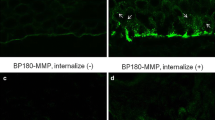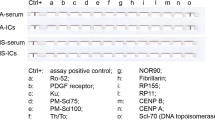Abstract
Anti-nucleolin antibodies have been detected in patients with systemic connective tissue diseases (SCTD) including systemic sclerosis (SSc) and systemic lupus erythematosus (SLE). In vivo bound autoantibodies to nucleoli of epidermal keratinocytes have been demonstrated in skin from patients with SCTD. In this study, monoclonal antibody to nucleolin (D-3) was used to determine the distribution of nucleolin in different culture cells including HEp-2, HepG2, HRCC, Molt-4 and Wil2 cells. Nucleolin was found to be present on the surface of HEp-2 and HepG2 cells, but not on the surface of HRCC and lymphoblastoid (Molt-4 and Wil2) cells; in contrast, nucleolin was detected in the nucleoli of all permeabilized cells examined. In immunoprecipitation, using extracts from 32P-labeled HEp-2 cells as antigenic source, cell membrane as well as nuclear nucleolins were found to be phosphorylated with a molecular weight of 105 kDa. Viable HEp-2 and HepG2 cells were cocultured with IgG fraction of D-3 in a CO2 incubator for 1 to 24 h, and then permeabilized with acetone followed by immunofluorescence staining with FITC-labeled goat anti-mouse IgG antibodies. Nucleolar staining was observed in cells after 10 h or longer of coculture. These data indicated that D-3 antibody reacted with cell membrane nucleolin and subsequently gain access into cells in a process related to pinocytosis.
Similar content being viewed by others
References
Olson MOJ & Busch H (1978) In: Skin GI and Kleinsmith L (eds) Methods in Chromosomal Protein Research (pp 163–210) Academic Press, Inc, New York
Olson MOJ, Guetzow K & Busch H (1981) Exp. Cell. Res. 135: 259–265
Bugler B, Caizergues-Ferrer M, Bouche G, Bourbon H & Amalric F (1982) Eur. J. Biochem. 128: 475–480
Bouche G, Caizergues-Ferrer M, Bugler B & Amalric F (1984) Nucleic. Acid. Res. 12:3025–3035
Semenkovich CF, Ostlund RE, Olson MOJ & Yang JW (1990) Biochemistry 29: 708–713
Tan EM: Antinuclear antibodies (1989) Adv. Immunol. 44: 93–151
Prystowsky DS, Gilliam JN & Tuffanelli DL (1978) Arch. Dermatol. 114: 536–538
Deng JS & Ballou BR (1993) J. Invest. Derm. 100: 527
Ballou BT, Fisher G, Deng JS, Reiland JM, Waggoner AS & Hakala TR (1993) FASEB J. 7: 1308
Deng JS & Kumar V (1987) In: Beutner EH, Chorzelski TP & Kumar V (eds) Immunopathology of the skin, 3rd edition (pp 533–553) John Wiley & Sons, New York
Liebert M, Ballou BT, Taylor RJ, Reiland JM & Hakala TR (1985) J. Immunol. Methods 85: 97–104
West MA, Bretscher MS & Watts C (1989) J. Cell. Biol. 109: 2731–2739
Kovacsovics-Bankowski M, Clark K, Benacerraf B & Rock KL (1993) Proc. Natl. Acad. Sci. (USA) 90: 4942–4946
Srivastava M, Fleming PJ, Pollard HB & Burns AL (1989) FEBS Lett. 250: 99–105
Lischwe MA, Richards RL, Busch RK & Busch M (1981) Exp. Cell. Res. 136: 101–105
Chen CM, Chiang SY & Yeh NS (1991) J. Biol. Chem. 266: 7754–7758
Sapp M, Richter A, Weisshart K, Caizergues-Ferrer M, Amalric F, Wallace MO, Kirstein MN & Olson MOJ (1989) Eur. J. Biochem. 179: 541–548
Ballou B, Fisher GW, Deng JS, Reiland JM, Hakala TR, Srivastava M & Farkas DL (1996) Proc. Soc. Photo-Optical Instrum. Eng. 2680: 123–131
Author information
Authors and Affiliations
Rights and permissions
About this article
Cite this article
Deng, JS., Ballou, B. & Hofmeister, J.K. Internalization of anti-nucleolin antibody into viable HEp-2 cells. Molecular Biology Reports 23, 191–195 (1996). https://doi.org/10.1007/BF00351168
Issue Date:
DOI: https://doi.org/10.1007/BF00351168




